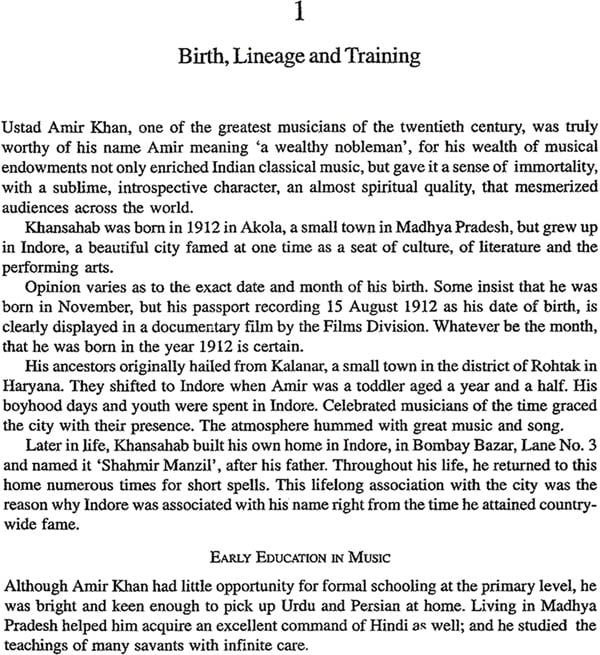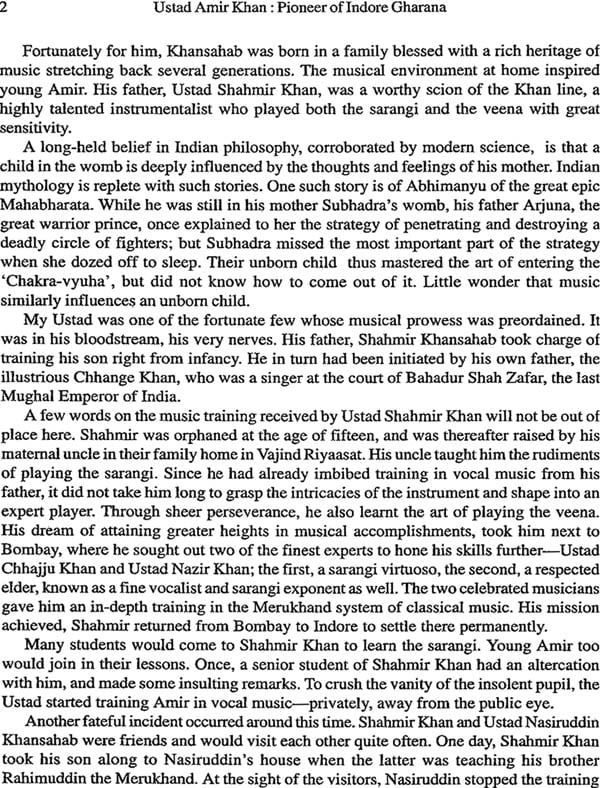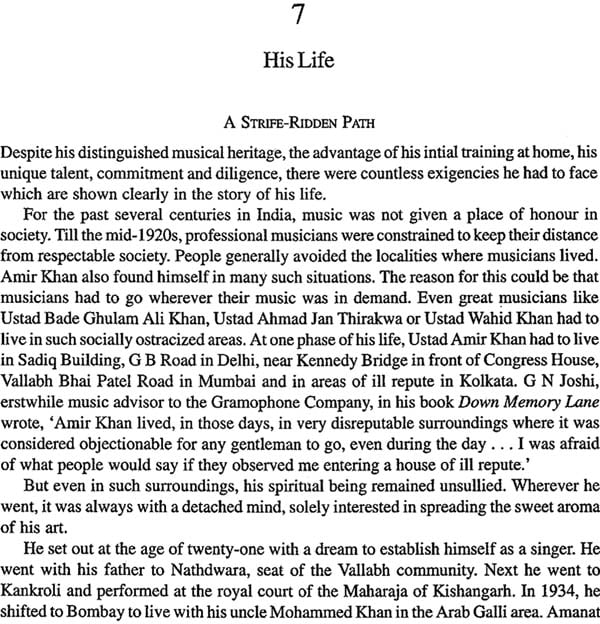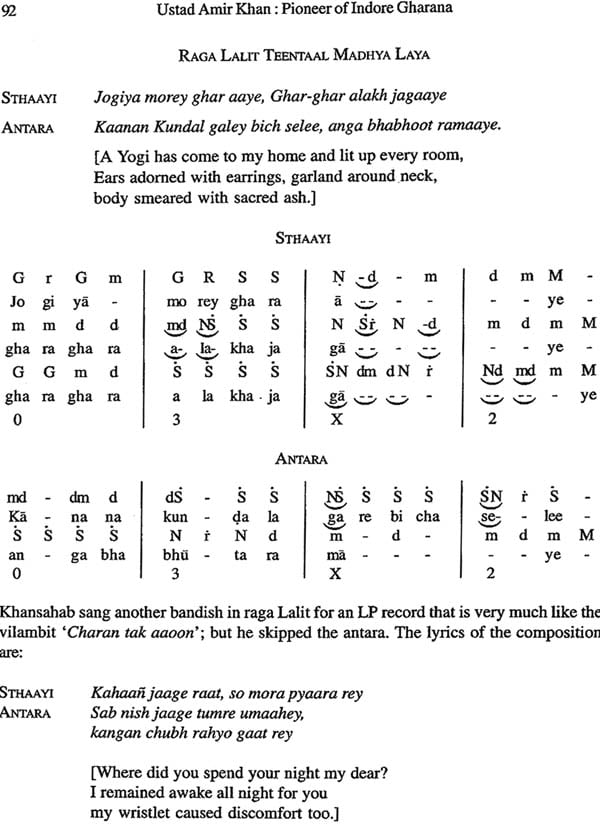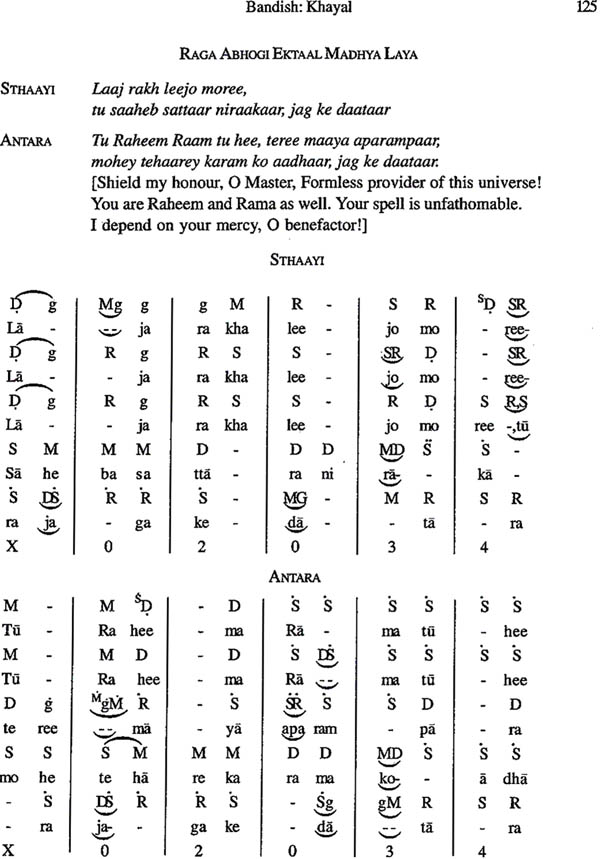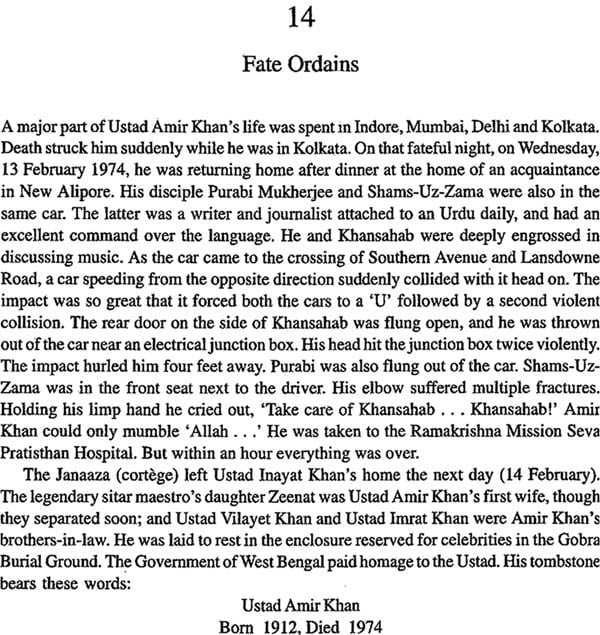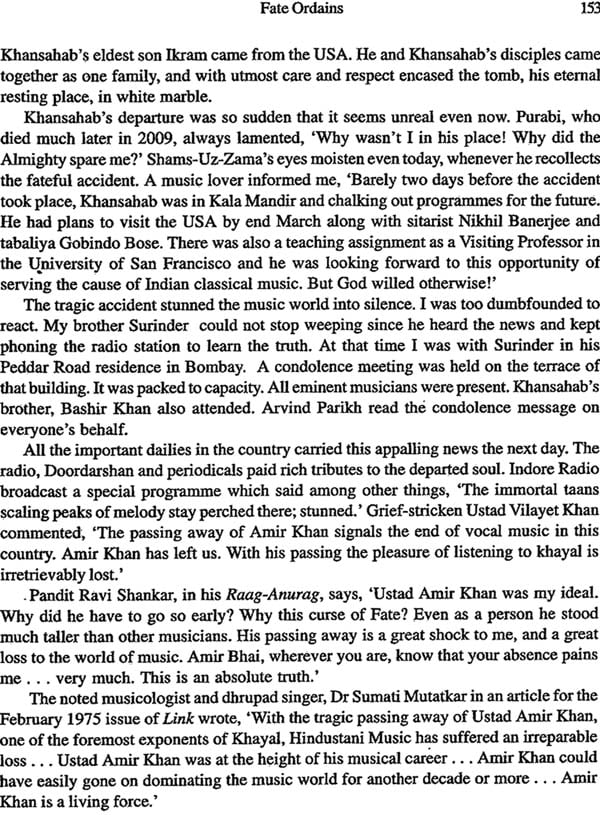
Ustad Amir Khan - Pioneer of Indore Gharana
Book Specification
| Item Code: | NAM894 |
| Author: | Pandit Tejpal Singh and Prerna Arora Translated by Meena Banerjee |
| Publisher: | Thema Books, Kolkata |
| Language: | English |
| Edition: | 2017 |
| ISBN: | 9789381703564 |
| Pages: | 200 (28 B/W Illustrations) |
| Cover: | Hardcover |
| Other Details | 9.5 inch X 7.5 inch |
| Weight | 560 gm |
Book Description
About the Book
In its original Hindi version, Pandit Tejpal Singh’s Biography of Ustad Amir khan (1912-74), One of the greatest vocalists of north Indian classical music in the twentieth century , has been described by S K Saxena , the distinguished music scholar , as ‘decidedly the most significant homage to the maestro.’ Trained by Khansahab directly over a long period , Tejpal Singh and hi s disciple Prerna Arora have reconstructed the master’s life and provided a comprehensive account of his insight and perceptions about music , drawing on Singh ‘s conversation with him. But the most invaluable part of the book is the collection of the rare bandishes that khansahab sang, with their notations . With his great concern for the meaning of the lyrics, he had ensured that the texts were preserved by his disciple in their authentic form.
Tejpal Singh (b. 134) is best known as one of the couple of singers (the other being surinder Singh ) who describes themselves as ‘Singh bandhu.’ The duo received their initial training in vocal music from Sri G S sardar, and thereafter from Ustad Amir Khan of the Inode Gharana. Well known exponents of Gurbani and shabad Kirtan, the Singh bandhu brothers have produced a large number of recording of both Hindustani classical and sikh devotional music. With a Master in Mathematics from deli University , Tejpal Singh has taught at the Government college, Gurgaon and headed the music Department of the Government Music college for women in Rohtak. He has directed music for films and television serials including Govind Nihalani’s Tamas. Tejpal and Surinder Singh have been honoured by many organizations including the Shaitya kala Parishad , Delhi (11986). They have also been recipients of the State Awards of the Punjab and Haryana Governments , the Rajiv Gandhi Memorial award (1995) and the Sangeet Natak Akademi award (2004).
Prerna Arora is a Disciple of Pandit Tejpal Singh . With a PhD in Music from Delhi University, she is associate Professor and head of the Department of music a Janki Devi Memorial college , One of the Constituent college under Delhi University.
Meena Banerjee, Musicologist and critic; received her training in Hindustani classical music from Pandit Amarnath of Indore gharana , and in Rabindrasangeet from SM sumitra Sen; and has been widely acclaimed for her recitals an lecture-demonstrations in north Indian classical vocal music throughout India., southeast Aasia, Europe and Africa. With a Aster in Sanskrit, a deft Command over Hindustani dialects, as well as Hindi, English and Bengali , she has published several research papers and translation. She has held administrative positions in Sahitya Kala Parishad., Delhi; and teaching and editing positions in ITC Sangeet Research Academy , Kolakata. A regular contributor to major newspaper and periodicals since 1984, She has been awarded for r cultural journalism With the Media Excellence Award, 2015 and the abhinavgupata Samman , 2016.
She Follows up her widely appreciated Bengali translation of Sangeetsurya Ustad Amir Khan With the Present translation in English , also containing her own Evaluation of Khansahab.
Oral tradition as at the core of pedagogy in Ancient India. all subject including religion, philosophy, economics, medicine, logic and of course the arts, were transmitted orally by master to pupil, ‘guru’ to Shishya’. That is why the Vedas are also known as Shruti which literally means ‘as conveyed by the ear.’ Even in the Smriti shastras (conveyed by memory) which came later we find echoes of Shruti. Indian music followed this practice of handling down the tradition from teacher to student. In tie, the individual teacher’s interpretation of traditional led to the formation of different schools.
Ustad Amir khan’s voice and his style of singing made an indelible impact in the world of Indian classical music . His brilliant musical career , which spanned nearly three decades ended abruptly in a fatal car accident in 1974 when he was at the peak of his popularity. Far more sophisticated in thought and expression than musicians before and after him, he was much ahead of his times. His innovative style is known today as the Indore Gharana.
Volumes have been written on Ustad Amir Khan’s style of singing. so another book on him? Firstly, my humble submission is that I was one of closest disciple , blessed to be in his company for a considerable period of time . even after the sudden and untimely departure of Khnasahab, I continue m musical journey in the direction e had guided me . whatever experiences he shared with me guide to this day. I hold him close to my heart as a son does his father , and I feel duty bound to share my understanding of him with the wider world ; especially since more of his other close associates have recorded their experiences with Khnasahab and his music.
Secondly, whenever approached by any of my fellow students (guru-bhasis) or other musicians, I have happily shared my guru’s Compositions and whatever little knowledge I have of ragas. A few have acknowledged this but most forget to mention the source of information, and at times even misrepresents facts. this has compelled me to write a comprehensive book which would answer all question for those musicians, students and research scholars who are genuinely interested in khansahab, his music and his compositions.
I also saw the necessity of scoring Khansahab ‘s precious repertoire including inherited compositions as well as hi s own originals .In India It is common practice to avoid inscribing what is considered arcane knowledge . this leads to an irretrievable loss . In the absence or proper notation , we have lost numerous traditional compositions of his merit both literary and musical . several great musicians who inherited such traditional compositions , have composed their own bandishes (lyrics) have no importance in classical music . Regardless of such vicissitudes, musicians in general still refuse easy access to their favourite compositions , jealously guarding what they have learned through years of arduous endeavour. I am no exceptions either. Whatever treasure I have today, was handed down to me by my Ustad only after he was sure that I was sincere and worthy enough to have them . we would discuss threadbare the poetic aspects of every compositions a song with the key melodic phrases that help define the characteristics of a raga . I genuinely and melodic charm intact.
Erudite musicologists have written about khanasahb based on information gathered from (and filtered by) others . I cannot match their intellectual or linguistic prowess; but whatever I know of Khansahab , is based on may direct interaction with him. I did not have rely on hearsay; but have tried my best to put on record every thing khansahab conveyed to me himself regarding his life an works. I have set down whatever I acquired as a disciple of my Ustad. These are plain facts in pain language that is a mix of Hindi and Urdu; and in my endeavour I have received commendable support from my disciple Dr Prerna Arora , a Doctorate in music from Delhi University and Head of the Department o f Music at Janaki Devi Memorial college.
I am convinced that everything happens by the grace of the Almighty. He provides inspiration, perception, opportunity, time and energy to set and achieve a goal , Very few may be as blessed as sachin Tenfulakar; but we all are blessed in One way or other . I am grateful to god for inspiring me to labour on in my chosen field - Music. I am grateful to my guru Ustad Amir Khan for guiding me to develop a clear perception of this highly technical subject. I am grateful to my elder brother Shri G S Sardar who initiated me to music. It was due to his training that I could get the opportunity to learn from the legendary Ustad. I am grateful to my wife Dr Renu Sachdeva, Ph D (music ), whose ever So competent supervision and care enabled me to devote myself full tie to this, almost sacred, mission. Still , this work would not have been possible without the help of professor Sharif Hussian Qasmi , Head of the Prsian anguage Department, Delhi University. He gave his valuable time explain the literal meaning and correct pronunciation of the Persian verses. And I m grateful to Kanishka publishers for publishing and distributing this book with such interest.
When the book was officially released in Kolkata at 2006, I was approached by many to get it translated in Bengali as almost all Bengali musicians are great admires of Ustad Amir Khan . I could not think of anyone more suitable for the job than Ms Meena Banerjee, a disciple of my elder gurubhai Pandit Amaranth. The Gharana link a part , she is an eminent musicologist wit command over several languages. She has translated valuable books on music like pandit Kumar prasad Mukherji’s Kudrat Rang –Birangi and komal Gandhar (autobiography of Ustad Vilayet khan, compiled by Shankaral Bhattacharya) in Hindi.
The Bengali translation Sangeet Surjo Ustad Amir Khan, with unprecedented use of diacritical sins, ventures to give the exact pronunciations of Urdu and Persian words along with hat of Brij and Bhojpuri dialects. I am grateful to meena-ji for this path breaking endeavour. I am indebted to Thema Books for accepting the challenges thrown by this extra responsibility. No sooner had the Bengali version hit the market in 2010, I wanted this wonderful team to gave me an English version to commemorate the birth Centenary year of Ustad Amir Khan in 2012!
The nation is celebrating the centenary with great reverence ever since the Ramakrishna Mission Institute of culture took the initiative in Kolkata in august 2011.
This Book is the outcome of whatever musical knowledge I acquired at the feet of Ustad Amir Khan , my mentor and the pioneer of a new musical line that has influenced not only vocalists of different Gharanas and genres but instrumentalists as well. As a result my thoughts remain essentially focused on all those unique components and characteristics that define the Indore style of Singing as an independent gaharana in the world of Hindustani classical music. Agreed, this is an assimilation of different styles; but Ustad Amir Khan With sharp intellect, quick grasp and editing power, evolved a totally new style and put his own inimitable stamp on it.
Usually , a Gharana is recognized by its exclusive voice –throw. Indore stands tall in this respect. The introspective , natural yet intoxicating well – rounded voice throw of Ustad Amir Khan remains unparalleled but it has set the standards which inspire his followers to explore the expanses of two and half octaves without being gruff, shrill or unnaturally forceful.
Like all other major Gharanas, Indore too has the Astaangas (eight facets) of khayl singing; but in a very aesthetic manner, at times too subtle to be distinguished by the best of listeners! Commencing with a succinct phrase as the explicit introduction of the raga with aa or (short form of Allah), Khansahab would inject spirituality before singing the sthayee (frst stana) of the Bandish (compositions). He Would repeat it twice with clear enunciation; to let the melodic, rhythmic and literary aspects of the compositions leave a clear impression of the raga’s special quality , the melody ‘s setting within the rhythmic cycle with ‘sam’ and khaali’, and the emotive content of the lyrics. Most of the slow Khayals iof Indore are sung in extra slow jhumra which gives the refrain a much wider canvas. Khnsahab used to treat the raga according to the mood of the lyrics and melodic structure o the compositions ; for example , he has sung several varieties of Bageshri with special emphasis on a special quality of the raga.
Next comes Badha , the most important aspect of the Indore style. This is a taalbased meditative alaap a la dhrupad with the help of syllables chosen from the lyrics of the compositions. each important note of the raga comes as a landing before the others one is addressed with due respect, replete with ‘kaan’ (touch notes) or ‘nyaas’ (standing notes) as he raga demanded . the art of applying the principles of Merukahnd plays an important role here . In this the bars of the taal remain totally unseen , unheard; but approach to sam inspires layakaari (rhythmic patterns). This Part is close to ‘behlaawa’ (cajoling with notes). The most striking character of this badhat or slow elaboration is that it is ‘avaroh-mukhi’) (in descending order) and blends tea cent with grace, strength and a serene introspective mood. By the time this elaboration touches the upper tonic , the raga is completely established in its full glory . the antara or the second part of the compositions , therefore , comes as an extension of the sthayee.
While treating the Medium paced bandish the ‘mukhda’ (refrain) gets treated with varied innovative melodic phrase of the raga. Kahnasahab was never in favour of Bol-Baant’ (division of lyrics to show rhythmic patterns) nor did he like the vociferous rhythmplay in the form of ‘Sawaal Jawaab” (question and answer) with the table ; but he was not averse to its subtle, aesthetically appealing use. He therefore, evolved a new method with sargam (sol-fa-syllables) with engaging rhythmic patterns, designed out of Merukhand’s mathematical permutations. It gave the same thrill without butchering the lyrics!
His Preferences for ‘unchhal ki taan’(leaping tans) or ‘pukaar ki taan’ (tans punctuated with emotive phrases) displayed his deep respect for the untampered literary beauty of the compositions. at high speed his superfast sargam tans with unpredictable twist and turns offered a series of surprises.
The Indore Gharana’s Tarana a singing is yet another unique aspect. Usually treated s mnemonics of percussion instruments , most pundits treat the taraana lyrics a s a meaningless; nut not Ustad Amir Khan any syllable , according to him, is not without meaning or emotion furthermore, apart from giving it a novel melodic style he added a deeper spiritual colour to Taraana singing and also embellished it with a thrilling climax consisting of a rubaai or an Urdu Couplet.
In short this gayaki (vocalism) does not intend to titillate the mind with mere virtuosity, but to touch the heart at the inmost depth of emotions steeped in melody . this is more contemplative than entertaining, more solemn than histrionic . and yet both of these conflicting moods are presents in it.
All these characteristics se the Indore Gharana apart from the rest. Eminent musicologist /author Vamanrao Deshpande acknowledged Indore as an independent Gharana in his book Ghrandaj Gayaki (in Marathi, published I 1961); and rightly so this style’s unmatched popularity had transcended all barriers during the short life -span of its creator Ustad Amir Kahn . Even four decades after his untimely demise, there are many eminent musicians who acknowledge him as their mentor; there are many who do not accept this fact but their music reveals his indelible impact loud and clear . Moreover his direct disciple are carrying forward the legacy and the fourth generation is making its presence felt now.
Contents
| Foreword | vii | |
| Preface to the English Version | x | |
| Why this translation | xiii | |
| 1 | Birth, Lineage and Training | 1 |
| 2 | Influence of contemporary Musical Stalwarts | 15 |
| 3 | A Mix Gayakis: Bouquet or Elixir? | 23 |
| 4 | The Distinctiveness of Ustad Amir Kahn’s style | 27 |
| 5 | In depth analysis f a Complex style | 38 |
| 6 | The Indore Gharana | 43 |
| 7 | His wife | 46 |
| 8 | His Personality | 52 |
| 9 | Ustad Amir Khan as a Guru | 64 |
| 10 | Some Concerts and Honours | 72 |
| 11 | Singing for the Cinema | 80 |
| 12 | Bandish: Khayal | 85 |
| 13 | Bandish Taraana | 138 |
| 14 | Fate Ordains | 152 |
| Appendices | ||
| Compositions documented in this book | 155 | |
| Discography of available audio recordings | 158 | |
| His disciples | 160 | |
| Glossary | 161 |
Sample Pages
